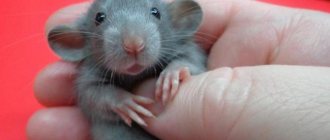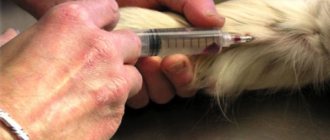Getting a new pet, especially if it's your first pet rat, is one of the most exciting experiences in your life. You'll want to hold your pet from day one, but it's important to follow the process to ensure your pet becomes your best friend in the future. It is important to gain the trust of your new pet rat and this will require a lot of patience.
How long will it take to tame
When you first bring a rat home, don't try to start the taming process right away. Moving from a pet store or breeder to your home will make your new friend nervous. Give the animal enough time to get used to its new place of residence. Give your pet 1-2 days to adjust to its new home.
It's best to simply place the rat in a new home (whether a cage or aquarium) and let it settle in. Make sure your rat has a full bottle of water, some food, and some chew toys to relieve stress. Shelters are also necessary, whether it be a store-bought rat house or a simple box full of soft bedding or material. Don't force your new friend out of the cage - be patient and understanding.
The time it takes for a rat to be tamed to a human depends on several factors:
- Age of the rodent. Baby rats are much easier to tame than adult rats. The younger the animal, the faster it gets used to being handled.
- Place where the animal was purchased. If you purchased a rat from a pet store, it may be half wild. Responsible breeders, on the contrary, communicate with rodents every day and slowly tame them. Such a rat can get used to you within a few days after purchase.
- Rat temperament. It is important to remember that all rats have different personalities. Depending on the personal qualities of the animal, the taming process can take from 2-3 days to 2 months. You need to pick up the rodent more often or carry it in your pocket so that the rat gets used to you. Even if at first the rat expresses dissatisfaction, then it will get used to it and become tame.
Conditions of detention
In order for the rat to get used to your hands as quickly as possible, it is necessary to organize comfortable living conditions for it. Only after feeling completely safe can the animal begin to establish relationships with its new owner. The main rule is that there must be enough space in the cage.
Mandatory interior elements include:
- plastic tray with specialized filler;
- cozy house;
- equipment for exercises: wheel, ladder, labyrinths;
- bowl and drinking bowl;
- special sharpener for teeth;
- equipped place to sleep.
The cage needs to be cleaned when it gets dirty. The animal's dishes must be thoroughly washed daily. Once a month, general cleaning is carried out using disinfectants. It is also necessary to ensure that the rat is always fed and there is clean water in the drinking bowl.
Separately, you will need to take care of the microclimate. The room in which the rat is kept must be protected from cold air and drafts. The optimal air temperature for rodents is +18-21°C. Also, rats do not like the sun, so it is better to choose a room on the shady side to keep the animal.
How to tame a rat
When you first get new rats, it will take some time before they trust you and want to get close to you. The main thing is to take your time and follow the following process:
- For the first few days, allow the rats to settle into their new home without the added stress of being at the hands of a stranger.
- After a few days, when the rats have become somewhat accustomed to their new home, you can begin to interact with them. But you shouldn't just grab them. After all, they still don’t know you and are afraid. They will need time to relax and understand that you are not a threat. You can use treats to lure them out of their cage. Eating treats from your hand will be a positive experience for them, which will be the first step towards them trusting you and starting to bond with you.
- Now that your rats are comfortable enough to eat from your hand, you can try petting them. Let them smell your hand. Approach slowly and keep your hand steady so that sudden movements do not scare them away. Rats use their teeth to explore objects, which is why your rat may bite you. You can show the animal that this should not be done by making an “eep” sound. This is how rats usually tell each other that they don't like something.
- When rats are no longer afraid of your hands, you can gently stroke them on the head, behind the ears, or from the neck to the back, but avoid the area around the tail, as they are very sensitive.
What to do if the animal is afraid, bites and breaks out
By its nature, the decorative rat is completely non-aggressive. Although there are some exceptions. But, nevertheless, in many cases, bites are not a manifestation of anger, but a defensive reaction. Therefore, you need to understand the question of why the animal began to bite.
If the little rat had not bitten before, and then began to do so, then most likely your behavior or that of your family members has shaken his trust. Remember if you have pushed, pinched or stepped on an animal recently. Such actions, like physical punishment, can cause not only a desire to bite, but also fear. In addition, a tamed animal can escape from one’s hands, although there were no problems before. Physical pain for a pet is a threat to it, so this behavior is a defensive reaction of the rat.
But the desire to bite does not always mean aggression. In the natural environment, rats use it to communicate with each other. And you are now part of her family.
Bites can mean many things:
- interest - the animal gently nibbles with its teeth;
- thirst for affection - bites as if biting off the fur of a relative;
- showing superiority - trying to show with a bite who is in charge in the family;
- attracting attention - a sudden bite from an unexpectedly visiting pet;
- playful mood - bites, runs away and comes back;
- warning - a response to your actions, as an option it hurts him;
- fright - after a bite the pet runs, breathes heavily, wants to hide.
During puberty (at 5–7 months of life), males may begin to bite, hiss and snort. This is hormonal maturation, growing up and defending territory. Females mainly bite when they are pregnant or caring for pups.
Also find out how to teach a rat to go to the toilet in a litter tray.
To prevent your pet from becoming aggressive, you need to:
- provide the rat with peace during the adaptation period;
- do not insert food or fingers between the cage bars, only through the door;
- play with the animal every day;
- reduce the noise level around your pet;
- Do not hit the rat under any circumstances.
Any attempts to bite must be stopped. If a rat bites, drive it away from you. She will quickly understand that this cannot be done. If a rat bites you, you must squeeze out the blood from the wound to prevent inflammation, treat it with peroxide and an antiseptic. You can visit the hospital if you wish. The main thing is that the animal is vaccinated.
If the wound is severely inflamed, there is a headache or muscle pain and fever - this is a reason to seek help at the hospital. Manifestation of aggressiveness is a kind of rebuff to your behavior; correct it, and the animal will begin to trust you again.
How to tame a rat
At first, the rat does not like being picked up by its owner. Imagine being lifted into the air by a creature several times your size and holding you several meters above the ground! To tame a rodent, you must follow certain rules. Follow the tips below to make the process easy and painless.
- Be slow and gentle with your rat. Sudden movements will frighten your pet rat and cause it to avoid you for a while. Once your rat is comfortable with you and your hands, you can slowly pick him up. Try touching your rat's belly with your fingers as you pet it. These rodents don't always like to have their belly touched, but the best way to pick up a rat is to grab it by the belly.
- Place one hand under the rat's belly. Lifting the rat from this central point will help maintain balance and give you a better grip on the rat. Since your pet rat will most likely squirm, do not let it jump out of your hand and fall to the floor. When you lift the rat by its belly, try to have it rest its tail on your hand or on your palms. Your rat's long tail helps maintain balance and will swing in the air.
- Lift the rat with both hands. Once you have your hand around the rat's stomach, use your other hand to hold it down for added security. After all, an animal can jump out of an open palm and possibly get hurt. Two hands will also help your furry friend feel more secure in your palms. The more you handle rats this way, the more comfortable they will become with you.
- Walk around the house with the rat. So, your rat finally allows you to pick him up without any problems. To improve your relationship, let her crawl up your arms and sit on your shoulders. Pet rats love to travel around their owners, and your shoulders are the perfect place for them to perch while you walk or relax. If you're wearing a hoodie, try placing a rat in the hood. There they will feel safe and have enough space to relax. Who knows, your furry friend might even fall asleep on you.
Possible consequences of rat bites
Abrasions, puncture and lacerations, hematomas, bruises are possible consequences of an encounter with a rodent. However, with well-planned treatment and care for the injury, the risk of complications is minimal.
Wound festering is the most common of these. The affected area is opened and drained. This complication can be avoided if you properly care for the wound. In advanced cases, soft tissue may be deeply affected, requiring amputation.
What infections do rats spread?
Rats have long been considered carriers of diseases, including viral ones. Of these, the most dangerous are the following:
- Sodoku is a rat bite disease that is fatal in 10% of known cases. It can be avoided if treatment is started on time;
- tetanus - the risk of death after infection reaches 20–30%. Tetanus ranks third among the most dangerous diseases after rabies and plague. Even after recovery, dangerous consequences are possible in the form of heart paralysis, pneumonia, sepsis;
- Leptospirosis is transmitted not only through saliva. If you notice that the animal has chewed the bread, then it is better not to eat it. The disease is dangerous due to paralysis, myocarditis, renal failure, infectious-toxic shock;
- pseudotuberculosis - dangerous for the development of meningitis, polyarthritis, osteomyelitis, myocarditis.
The risk of contracting rabies is minimal, however, it is a rather dangerous disease that requires prompt treatment.
Taming a little rat
After a couple of days of rest and relaxation in their new home, you can begin to bond with your little rat. Let your new friend come to you on his own. It is very important not to force the baby rat out of the cage, otherwise you will lose his trust. When you try to call your pet, he will be very careful. This behavior is normal for them, so be patient. You should introduce yourself to your baby slowly, step by step. The best way to do this is to lure or call the baby rat to the cage door and to your hand.
Treats will help lure your little rat out of the house. Snackable treats are the best way to gain your little rat's trust. As time passes and with all the treats you give your pet, your little rat will begin to trust you and will try to leave the cage on its own in your presence. You should give your rats store-bought treats, such as dried fruits and nuts, or rat-safe homemade treats.
In general, taming a baby rat will take much less time than gaining the trust of an adult rat. The main thing is to be careful and have patience.
Answers
Evil Fairy 6 (17408) 3 24 1148 6 years
Better than green paint, it is less aggressive to the skin of children.
Aksi 6 (12738) 2 7 177 6 years
Peroxide and only peroxide should be used to disinfect ANY wounds (applies not only to children). The pharmacy costs about 0.48 ls. You literally need to water the wound 2-3 times a day, do this for a couple of days and everything will heal.
Alessio 5 (3835) 1 25 78 6 years
When I was a child, I had a hamster that was so fluffy and had huge yellow teeth. My parents told me that if you put your finger in the cage it will bite, but I’m not a fool, I decided to check... my hamster pierced my finger, right through. it hurt, at first I cried, then I laughed for a long time :]]] they anointed my finger with iodine and everything healed. this is my story
Mruta_ 7 (21254) 7 79 213 6 years
If the rat didn’t live in garbage dumps, then it’s okay, just disinfect the wound. Home for me too. The rat even bit my finger once until it bled, it hurt, but nothing tragic happened)
hawketeer 6 (16339) 4 13 63 6 years
If the rat is vaccinated, then wash the wound and transport it.
asdf777 6 (8227) 2 2 18 6 years
Sorry, not a doctor, that's why. in general, I would definitely show the doctor and still use the antibiotic intramuscularly. Why? Yes, the rat is a domestic one, but what did it eat? How clean are her teeth? And this infection can enter the baby’s blood and cause sepsis. This is not harmless at all! Zelenka and iodine are only disinfected on the outside, a bandage is not needed at all, the band-aid is also nonsense. Damn, why the hell give advice if you don’t understand them. This is a small child.
You can choose completely different pets - large, small, bald, hairy, with a variety of colors and characters. When purchasing a decorative rat as a pet, you should follow several rules to ensure safety. The rodent has sharp teeth and claws. If necessary, he can use them. A rat bite, painful and unexpected. Why did your beloved pet suddenly start showing aggression? Let's figure out what to do if bitten by a rat?
Can you tame a wild rat?
There are suggestions that wild rats can be tamed. But the process of gaining trust itself will require much more time, patience and effort. Especially if the pasyuk is already an adult.
By nature, wild rats are cautious, timid and reserved. They are wary of people, constantly hiding and running away from danger. Therefore, it will be very difficult to establish contact with them.
The main thing is not to touch them initially, much less try to lift them. Animals will perceive such actions as aggression, start screaming loudly and try to run away. You should not touch the rat during 2-3 weeks of living in a new home.
There are times when rats refuse a treat offered by hand. Then you can skip one feeding session so that the animal feels hungry. However, under no circumstances should you starve a wild rat for too long, as this will make it aggressive.
A wild rat cannot be tamed for several months. However, with patience, kindness and regularity, a positive result will be achieved.
Search algorithm
When unplanned events happen, it can be easy to feel lost. What to do if the rat runs away and you suddenly find an empty cage?
- The most important thing is to calm down. Think about where in the apartment the baby could get hurt, immediately turn off electrical appliances and hide anything that could burn him.
- Limit your search area. Close doors and windows carefully.
- Check out your pet's favorite spots.
- Continue searching in places that may interest the animal. Decorative rats, of course, are not chameleons, but rodents are excellent at “merging” with surrounding objects. The owners note that sometimes they can be detected only by touch - they can camouflage themselves so professionally.
- Listen carefully to every sound. Turn off the TV and radio, let the silence in the apartment be ideal during the search. There was a rustling sound - immediately look for the source of the sound.
Veterinary assistance
At the veterinary clinic, the first thing they ask is about the completeness of the vaccination. If everything is in order with vaccinations, then the veterinarian will simply record a case of a bite. If there are no vaccinations or the vaccine was administered insufficiently, then the dog will undergo a course of vaccination. The most commonly used serum is for tetanus, rabies and leptospirosis.
A rat bit a dog, what should you do if your pet was not taken to the vet? – There are times when a dog owner decides to limit himself to treating a bitten dog with improvised means. In such situations, you need to strictly monitor the condition of your pet. The following symptoms may be cause for concern and a trip to the veterinarian:
- change in gait;
- convulsions;
- excessive salivation;
- disruption of normal behavior;
- temperature increase.
If you notice suspicious symptoms after your pet has been attacked by a basement rat, you should immediately take the dog to the veterinarian.
How do rats bite?
Rats almost always bare their fangs in an open fight. The instincts of our smaller brothers lead to a clash. Dogs almost always try to chase down a rat. You will be lucky if several or even more dogs chase the rat at once. Hunting group tactics consist of one dog blocking the rat's path, and the second pressing it with its teeth. Dachshunds and Yorkshire terriers are considered natural rat catchers. By the way, small Yorkie dogs were bred specifically for these purposes, that is, to chase rodents around.
Causes
To maintain good, friendly relationships, you should avoid situations in which the rat might bite.
The pet was hurt; Scared; Hungry animal; The desire to attract attention.
Bites without a reason in domestic rats are practically excluded. If you squeeze an animal for a long time, then when it gets tired, it can gnaw lightly, thereby saying “enough.”
After preparing or eating food, you should also wash your hands thoroughly so that the smell of your fingers is not confused with food.
A rat may also bite another pet, such as a cat or dog. The reasons are the same - protecting one’s territory, fear, approaching danger. It happens that pets get along nicely next to each other and even play.
With a strong bite, the wound may not heal for a long time, especially in an animal when there is fur nearby, which constantly irritates the “battle wound.” Bites are painful, but by providing comfortable conditions for all family members to stay in the house, they can be avoided.











